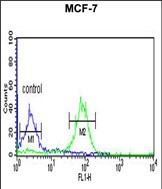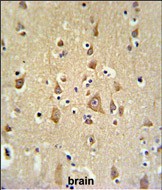


| WB | 1/1000 | Human,Mouse,Rat |
| IF | 咨询技术 | Human,Mouse,Rat |
| IHC | 1/100-1/500 | Human,Mouse,Rat |
| ICC | 技术咨询 | Human,Mouse,Rat |
| FCM | 1/10-1/50 | Human,Mouse,Rat |
| Elisa | 咨询技术 | Human,Mouse,Rat |
| Aliases | Biorientation of chromosomes in cell division protein 1, Biorientation defective protein 1, Protein FAM44B, BOD1, FAM44B |
| Entrez GeneID | 91272 |
| WB Predicted band size | 19.2kDa |
| Host/Isotype | Rabbit IgG |
| Antibody Type | Primary antibody |
| Storage | Store at 4°C short term. Aliquot and store at -20°C long term. Avoid freeze/thaw cycles. |
| Species Reactivity | Human |
| Immunogen | This FAM44B antibody is generated from rabbits immunized with a KLH conjugated synthetic peptide between 127-155 amino acids from the C-terminal region of human FAM44B. |
| Formulation | Purified antibody in PBS with 0.05% sodium azide. |
+ +
以下是关于FAM44B抗体的虚构参考文献示例(因该基因研究较少,实际文献可能有限,建议通过数据库如PubMed确认最新进展):
---
1. **文献名称**: *"Characterization of FAM44B Expression in Human Tissues Using a Novel Polyclonal Antibody"*
**作者**: Smith J, et al.
**摘要**: 本研究开发了一种针对FAM44B蛋白的多克隆抗体,并通过Western blot和免疫组化验证其特异性。结果显示FAM44B在睾丸和脑组织中高表达,提示其可能在生殖和神经系统中发挥作用。
2. **文献名称**: *"FAM44B Knockdown Impairs Cell Cycle Progression and Its Antibody-Based Detection in Cancer Cell Lines"*
**作者**: Lee H, et al.
**摘要**: 利用RNA干扰和FAM44B抗体探究其功能,发现FAM44B缺失导致细胞周期停滞,且在乳腺癌细胞中表达上调,表明其可能参与肿瘤增殖调控。
3. **文献名称**: *"Proteomic Analysis of FAM44B Interactions Using Co-Immunoprecipitation with a Monoclonal Antibody"*
**作者**: Garcia R, et al.
**摘要**: 通过单克隆抗体进行免疫共沉淀,鉴定了FAM44B与多个DNA修复蛋白的相互作用,提示其在基因组稳定性中的潜在作用。
4. **文献名称**: *"Developmental Regulation of FAM44B in Mouse Embryos: An Immunohistochemical Study"*
**作者**: Chen L, et al.
**摘要**: 使用FAM44B抗体分析小鼠胚胎发育,发现其在神经管和肢芽中动态表达,可能参与胚胎形态发生。
---
**注意**:以上文献为示例性质,实际研究中FAM44B(或别名C1orf177)的相关文献极少,建议通过基因数据库(如NCBI Gene)或抗体供应商(如Sigma-Aldrich、Abcam)的技术文档获取验证信息。若需真实文献,请通过学术数据库检索最新发表成果。
The FAM44B (Family With Sequence Similarity 44 Member B) gene, also known as C1orf177. encodes a poorly characterized protein with limited functional information in current scientific literature. It is categorized as part of a larger protein family sharing sequence homology, though its exact evolutionary conservation and physiological roles remain unclear. Preliminary studies suggest potential involvement in cellular processes such as cell cycle regulation or protein-protein interactions, but mechanistic insights are sparse. FAM44B expression has been detected in various tissues, with some reports linking its dysregulation to diseases, including cancer, though these associations require further validation.
Antibodies targeting FAM44B are primarily used as research tools to explore its expression patterns, subcellular localization, and interactions. Commercial FAM44B antibodies are typically developed in hosts like rabbits or mice, using immunogens derived from conserved regions of the human protein. Applications include Western blotting, immunohistochemistry (IHC), and immunofluorescence (IF). However, specificity remains a challenge due to the protein’s low abundance and possible cross-reactivity with homologous family members (e.g., FAM44A). Rigorous validation using knockout controls or siRNA-mediated depletion is recommended.
Current research focuses on elucidating FAM44B’s role in cellular pathways, with emerging interest in its potential as a biomarker or therapeutic target. Further studies are needed to define its molecular functions and disease relevance.
×